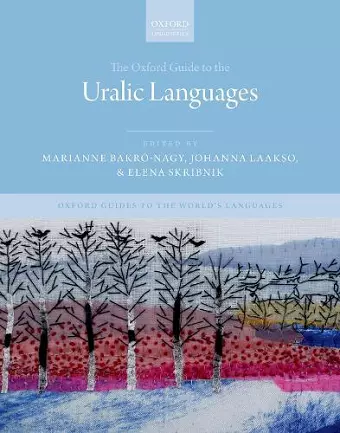The Oxford Guide to the Uralic Languages
Johanna Laakso editor Marianne Bakró-Nagy editor Elena Skribnik editor
Format:Hardback
Publisher:Oxford University Press
Published:24th Mar '22
Currently unavailable, and unfortunately no date known when it will be back

This volume offers the most comprehensive and wide-ranging treatment available today of the Uralic language family, a group of languages spoken in northern Eurasia. While there is a long history of research into these languages, much of it has been conducted within several disparate national traditions; studies of certain languages and topics are somewhat limited and in many cases outdated. The Oxford Guide to the Uralic Languages brings together leading scholars and junior researchers to offer a comprehensive and up-to-date account of the internal relations and diversity of the Uralic language family, including the outlines of its historical development, and the contacts between Uralic and other languages of Eurasia. The book is divided into three parts. Part I presents the origins and development of the Uralic languages: the initial chapters examine reconstructed Proto-Uralic and its divergence, while later chapters provide surveys of the history and codification of the three Uralic nation-state languages (Hungarian, Finnish, and Estonian) and the Uralic minority languages from Baltic Europe to Siberia. This part also explores questions of endangerment, revitalization, and language policy. The chapters in Part II offer individual structural overviews of the Uralic languages, including a number of understudied minority languages for which no detailed description in English has previously been available. The final part of the book provides cross-Uralic comparative and typological case studies of a range of issues in phonology, morphology, syntax, and the lexicon. The chapters explore a number of topics, such as information structure and clause combining, that have traditionally received very little attention in Uralic studies. The volume will be an essential reference for students and researchers specializing in the Uralic languages and for typologists and comparative linguists more broadly.
This book is a thoroughly admirable compilation. We can be very glad that it has been produced while at least a few speakers of most of these languages survive: a decade or two later it might have become very difficult to achieve such comprehensive coverage of one of the world's major language families. The book is well written and clear, despite the fact that scarcely any contributor has English as his or her mother tongue. * Geoffrey Sampson, University of Sussex, Linguist List *
This book is a thoroughly admirable compilation. We can be very glad that it has been produced while at least a few speakers of most of these languages survive: a decade or two later it might have become very difficult to achieve such comprehensive coverage of one of the world's major language-families. The book is well written and clear, despite the fact that scarcely any contributor has English as his or her mother tongue. * Geoffrey Sampson, Linguist List *
This book is meant for a linguistically oriented readership worldwide, throughout linguistic and related disciplines...I assume that typologists world-wide will also be happy to see this volume. * Roger Blokland, Keel Ja Kirjandus *
The Oxford handbook may now be recognized as the most comprehensive and reliable general tool on the Uralic languages...One of the strong sides of the volume is that it consistently relies on the established methods of synchronic and diachronic linguistics without trying to make far-reaching linguistic conclusions by resorting to information from extralinguistic disciplines. * International Journal of Eurasian Linguistics 5 *
The Oxford Guide to the Uralic Languages is a work of great scope and significance. A project of this magnitude undoubtedly required an immense effort on the part of everyone involved, and the dedication of the authors and editors is apparent in many ways. With a work of such ambition, it would be a miracle were all expectations even met in the first place. * Kaisla Kaheinen, Riku Erkkilä & Toivo Qiu, Finnisch-Ugrische Forschungen *
ISBN: 9780198767664
Dimensions: 284mm x 230mm x 62mm
Weight: 2898g
1172 pages